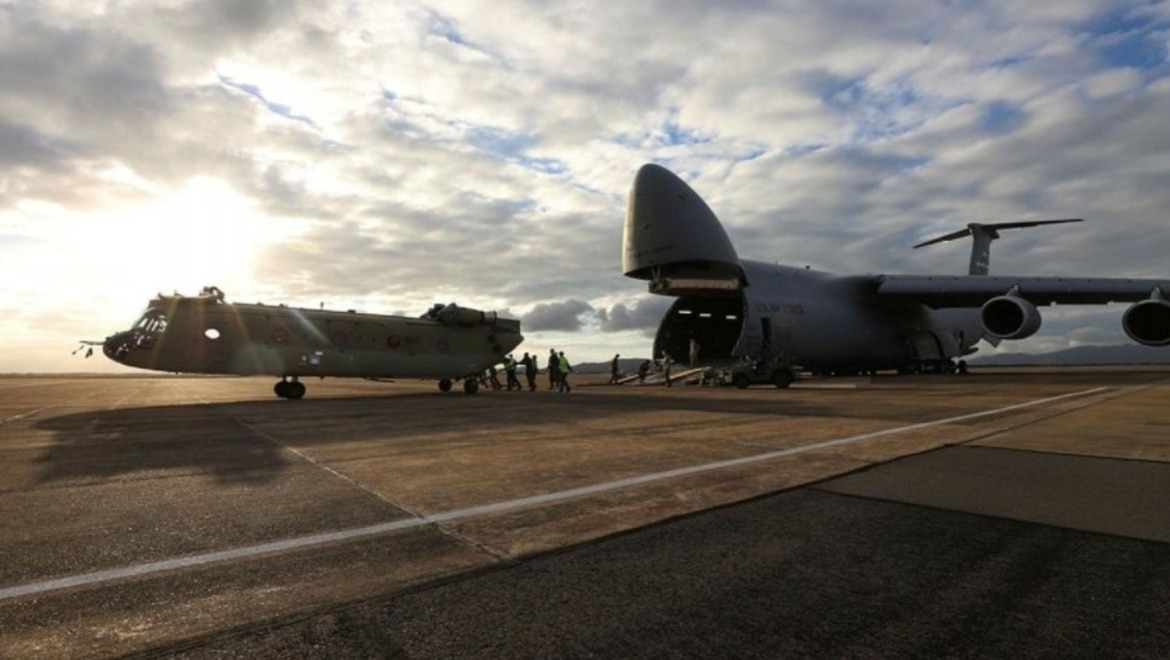
Boeing has delivered two of the four new Chinook’s ordered by Australia in a deal that has risen to $595 million.
The iconic aircraft was transported by a US Air Force C-5 Galaxy, pictured above, which has a 70-metre wingspan and weighs more than 172,000kg empty.
The arrival of the Boeing-built heavy-lift helicopters, flown by the Army’s 5th Aviation Regiment, 16th Aviation Brigade at RAAF Base Townsville, comes just weeks after Defence was forced to ground its fleet of 47 Airbus-built MRH-90 Taipan aircraft.
Minister for Defence Peter Dutton welcomed the arrival of the helicopters, which he said would strengthen Army’s airlift capability and support operations across the globe.
“The Chinook is Defence’s largest helicopter, with a long and proven track record of supporting ADF operations in Australia, our near region and further afield,” he said.
“This arrival comes approximately three months after the sale was approved and highlights Australia’s excellent strategic working relationship with the United States.”
Andy Builta, Boeing vice president, Cargo Helicopters and H-47 program manager, said the helicopters are capable of meeting both current and future battlespace requirements.
“While the aircraft’s exterior is iconic, the H-47 has incorporated the latest technologies to provide the world’s most modern digital avionics, flight controls and mission-centric capabilities,” he said.
It comes after Australian Aviation reported in March how Boeing Defence Australia also won a 12-month extension to its contract to support Australia’s fleet.
The updated CH-47F Chinook Integrated Support Services (CISS) contract will now run until 2025 and retains 45 jobs in Townsville, Oakey and Brisbane.
The Australian Army now has 12 Chinooks, many of which served in Afghanistan from 2006 to 2013, and were also deployed to help with the recent ‘black summer’ bushfire season.
Their primary roles include troop transportation, artillery emplacement and battlefield resupply, which they achieve via a wide loading ramp at the rear of its fuselage.
The Chinook has an extraordinary history within Australia’s ADF. Australia placed its first order, for 12, in 1972, with its delivery coming in October the next year.
No. 12 Squadron was formed at RAAF Amberley in September 1973 especially and became a dedicated Chinook unit.
Yet in 1989, the then Australian defence minister announced they were to be withdrawn on cost ground, to be replaced by Black Hawks.
No. 12 Squadron was disbanded and the RAAF Chinooks lined up to be sold.
Yet, just months later, that decision was spectacularly reversed, as it became clear the Black Hawks simply couldn’t compete.
The country was offered a deal – to swap its now ageing C variety with the more modern CH-47D that had played a major part in the Persian Gulf War.
The D featured composite rotor blades, new transmissions, rebooted avionics, and a rebuilt airframe estimated to last three decades.
A final deal for four was agreed, and today, the helicopters are in the custody of C Squadron of the Army’s 5th Aviation Regiment, based in Townsville.
The new Chinooks were purchased via a foreign military sales agreement for approximately $595 million.
The deal, approved by the US State Department in May, also includes:
- eight T55-GA-714A aircraft turbine engines;
- five AN/AAR-57 Common Missile Warning Systems (CMWS);
- eight Embedded Global Positioning System (GPS)/Inertial Navigation Systems (INS/EGI) +429; and
- two EAGLE+429 Embedded Global Positioning System (GPS)/Inertial Navigation Systems (INS/EGI).
The third and fourth CH-47F Chinook helicopters are scheduled to be delivered in mid-2022.
















M Coote
says:Fairly sure none of the current F Model Chinooks served in Afghanistan only the previous D Model which were replaced in the 13-15 timeframe by the current F Models.
John Millsom
says:This article has missed a lot of political/military infighting, not to mention rivalry between the Airforce and the Army.
The Blackhawk was bought to replace the UH1H as a battle field support helicopter, and Chinook replacement was never a consideration.
Gary
says:You forgot to mention that the CH-47Ds were replaced with CH-47Fs commencing 2015.
Martin
says:Adam, you wrote: “No. 12 Squadron was disbanded and the RAAF Chinooks lined up to be sold….Yet, just months later, that decision was spectacularly reversed, as it became clear the Black Hawks simply couldn’t compete”. I remember this decision reversal well, but as far as I recall, the original “C” model Chinooks had indeed already been sold by Defence before the realisation of the lost capability. Furthermore, I believe some of the former RAAF Chinooks were upgraded to “D” and redelivered to the Australian Army. I would have to check back issues of AA to be sure!
Michael
says:This government loves to throw money away in the name of defence, Australia CANNOT defend itself against any major power that decides to invade us. Chinook helicopters drastically overpriced, Hawkei vehicles costing $1m each, $5B for submarines we didn’t even get. Main battle tanks bought and serviced since 1975 that not one has seen service overseas since..hundreds of millions wasted there…the list goes on, seems to be open slather when it comes to defence, we would be flat out getting 5000 combat ready troops on the ground….What a joke. No wonder the yanks love us…we are helping to bankroll their industries at exorbitant prices.